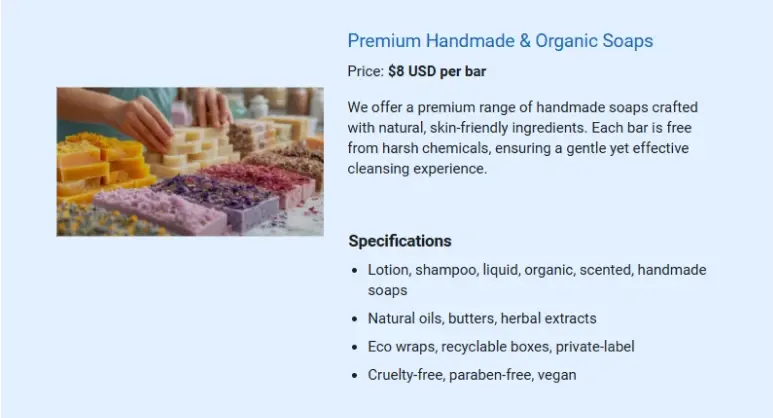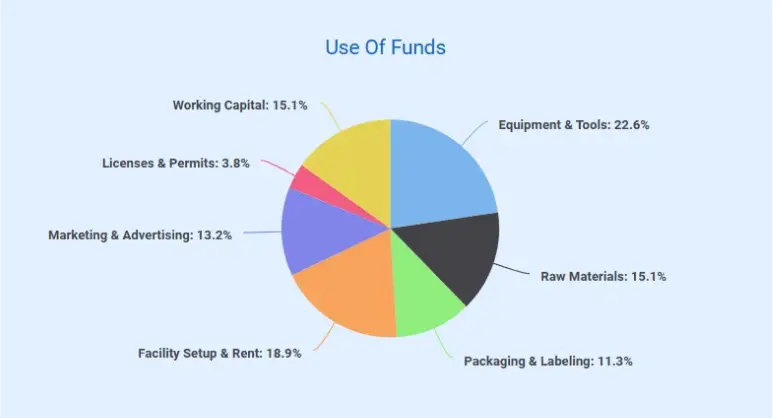So, you love making soap. Friends admire your amazing creations, your home smells like a luxury spa, and you’ve mastered the art of perfect lather.
Now, imagine turning that passion into a real business people rave about (and actually pay you for).
But great products alone aren’t enough. You’ll need a clear plan to guide your setup, growth, and long-term success.
Not sure where to begin?
This soap making business plan template walks you through every step so you can launch and grow your business with confidence.
How to write a soap making business plan?
Writing a soap making business plan is a crucial step toward the success of your business. Here are the key steps to consider when writing a business plan:
1. Executive Summary
An executive summary is the first section that offers an overview of the entire soap making business plan. However, it’s written after the entire business plan is ready and summarizes each section of your plan.
Here are a few key components to include in your executive summary:
- Business overview: Include the name of your soap making business, its location, when it was founded, and the type of soap making business (e.g., handmade, natural, commercial, etc.).
- Market opportunity: Summarize your market research, including market size, growth potential, and marketing trends.
- Products: Highlight the product line you offer to your clients. It may include handmade soaps, organic soaps, scented soaps, soap bars, liquid soaps, and lotion bars.
- Marketing & sales strategies: Outline your sales and marketing strategies—what marketing platforms you use, how you plan on acquiring customers, etc.
- Financial highlights: Briefly summarize your financial projections for the initial years of business operations. Include any capital requirements, startup costs, projected revenues, and profit forecasts.
- Call to action: Summarize your executive summary section with a clear CTA, for example, inviting angel investors to discuss the potential business investment.
Ensure your executive summary is clear, concise, easy to understand, and jargon-free.
Say goodbye to boring templates
Build your business plan faster and easier with AI
Plans starting from $14/month

2. Business Overview
The business overview section of your business plan offers detailed information about your company. The details you add will depend on how important they are to your business.
Yet, business name, location, business history, and future goals are some of the foundational elements you must include in this section.
Start by describing your business, providing all the basic information. State what kind of soap‑making company you run and its name. For example, you may operate a:
- Handmade soap‑making business
- Organic soap
- Private‑label soap
- Liquid soap
- Commercial soap
Describe the legal structure of your company — whether it is a sole proprietorship, LLC, partnership, or another form. Explain where your business is located and why you chose that location.
Next, list the owners of your soap‑making company, the shares they hold, and their responsibilities in managing the business effectively.
Then, summarize your business’s objective, core principles, and values in your mission statement, ensuring it is memorable, clear, and brief.
If you’re an established soap‑making service provider, include a short business history, noting when it was founded and how it has evolved over time. Mention any awards or recognition received for excellent work.
Finally, convey your aspirations and vision by outlining both your short‑term and long‑term goals. These may include specific targets for revenue, market share, or plans for expanding your business.
In simple words, this section should give readers a complete understanding of your business, its background, and its future direction. Keep it engaging, clear, and to the point.
3. Market Analysis
The market analysis section of your business plan should offer a thorough understanding of the industry with the target market, competitors, and growth opportunities.
You should include the following components in this section.
Target market
Define your ideal customer and explain what types of products they prefer.
Here’s a simple breakdown of key customer groups, their needs, and preferences for the soap products:
| Customer | Needs | Preferences |
|---|---|---|
| Hotel chains | Bulk supply of high-quality, branded guest soaps | Consistent quality, eco-friendly ingredients, custom branding |
| Spa chains | Luxurious soaps to enhance client experience | Natural/organic ingredients, calming scents, premium packaging |
| Retail stores | Private-label soaps for resale | Attractive packaging, competitive pricing, variety of scents |
| Online shoppers | Unique, artisanal soaps for personal use or gifting | Natural formulas, appealing scents, eco-friendly packaging |
| Corporate gifting buyers | Custom soap sets for events and clients | Custom branding, elegant packaging, premium quality |
Market size and growth potential
Briefly explain your market size and whether you’ll target a niche or a broader audience. Also, highlight the statistical data that shows the market growth potential.
For example, the global organic soap market was valued at $2.41 billion in 2024 and is expected to reach $4.17 billion by 2032, growing 7.33% annually.
Competitive analysis
Identify and analyze your direct and indirect competitors. Identify their strengths and weaknesses, and describe what differentiates your products from theirs. Point out how you have a competitive edge in the market.
Market trends
Analyze emerging trends in the industry, such as technology disruptions, changes in customer behavior or preferences, etc. Explain how your business will cope with all the trends.
There is a growing demand for natural and organic products, so explain if you manufacture or sell organic soaps, and if not, what you plan to do next.
Regulatory environment
List regulations and licensing requirements that may affect your soap making company, such as business registration, packaging and labeling requirements, ingredient regulations, environmental regulations, etc.
Here are a few tips for writing the market analysis section of your soap manufacturing business plan:
- Conduct market research, industry reports, and surveys to gather data.
- Provide specific and detailed information whenever possible.
- Illustrate your points with charts and graphs.
- Write your business plan keeping your target audience in mind.
4. Products
The products section should describe the specific soap products you’ll offer to your customers. Outline the different types, varieties, and unique features of your soaps, and explain what makes them appealing to your target market.
This section should include details such as product categories, ingredients, packaging style, and any special qualities that set your soaps apart.
Start by describing your product line. List the types of soaps your soap making company will offer. Your product line may include: lotion bars, shampoo bars, liquid soaps, organic soaps, scented soaps, and Handmade soaps
While planning, you can showcase your soap products with their image, features, and specifications for more clarity. Something like this :

Next, explain how you maintain quality standards consistently and provide the highest quality products.
This may include regular quality checks, testing pH levels, compliance with regulations, excellent manufacturing practices, and testing the final product for fragrance, texture, and performance.
And yes, don’t forget to discuss your final product’s packaging and labeling options, including sustainable and eco-friendly packaging options. Explain how you meet regulations by providing relevant information about your packaging process.
In short, this section of your soap making plan must be informative, precise, and client-focused. By providing a clear and compelling description of your offerings, you can help potential investors and readers understand the value of your business.
5. Sales and Marketing Strategies
Writing the sales and marketing strategies section means a list of strategies you’ll use to attract and retain your clients. To write this section, follow the steps given below:
Step 1: Define your USPs based on market, equipment, and unique products to guide marketing strategies.
Step 2: Define your pricing strategy to stay competitive in your local market and determine if discounts are viable to help customers initially and retain them.
Step 3: Discuss your marketing strategies to market your products—social media marketing, Google ads, brochures, email marketing, content marketing, and print marketing.
Step 4: Outline the strategies you’ll implement to maximize your sales, like offering competitive pricing, seasonal discounts, and product customizations.
Step 5: Describe your customer retention strategies and how you plan to execute them. For instance, loyalty programs, free samples, personalized service, etc.
Overall, this section of your soap making business plan can be the customer acquisition and retention area.
Use a clear, realistic, data‑driven approach for sales and marketing in your soap‑making business. Be ready to adapt and make changes based on feedback and results.
6. Operations Plan
The operations plan section of your business plan should outline the processes and procedures involved in your business operations, such as staffing requirements and operational processes.
Here are a few components to add to your operations plan:
Staffing & Training
Mention your soap making business’s staffing requirements, including the number of employees or production staff needed. Include their qualifications, the training required, and the duties they will perform.
Operational Process
Describe the operations and procedures you will implement to operate your soap making business. Your business operations could involve soap production, inventory management, marketing or sales, shipping and fulfilment, customer service, and administrative management.
Equipment & Machinery
Include the list of equipment and machinery required for soap making, such as mixing and blending equipment, heating equipment, cutting and molding equipment, safety equipment, etc.
Don’t forget to explain how these technologies help you maintain quality standards and improve the efficiency of your business operations.
Adding these components to your operations plan will help you lay out your business operations, which will eventually help you manage your business effectively.
7. Management Team
The management team section introduces the leadership at your soap-making business. It clearly describes the experience, credentials, and relevant responsibilities of each manager of the business.
Start by listing the business founders and the CEO. Explain their background, expertise, and roles to effectively run the organization.
Next, identify the key members of your management team and explain their responsibilities. If required, create a simple organizational chart showing reporting lines and decision‑making hierarchy.

If you work with advisors or consultants, include their names, roles, years of experience, and how they add credibility to your business.
You may also discuss your plan of compensation, especially for managers and staff, which typically covers base salaries, compensation incentives, and other benefits.
Overall, the management team section should clearly present your key personnel and demonstrate why your team is well‑positioned for success.
8. Financial Plan
Your financial plan section should provide a summary of your business’s financial projections for the first few years. Here are some key elements to include in your financial plan:
Startup costs: List the initial expenses required to launch your soap‑making business. Include equipment, raw materials, packaging, licenses, marketing, and setup costs.
Profit & loss statement: Describe details such as projected revenue, operational costs, and service costs in your projected profit and loss statement. Make sure to include your business’s expected net profit or loss.
Cash flow statement: The cash flow for the first few years of your operation should be estimated and described in this section. This may include billing invoices, payment receipts, loan payments, and any other cash flow statements.
Balance Sheet: Create a projected balance sheet documenting your soap making business’s assets, liabilities, and equity.
Break-even point: Determine and mention your business’s break-even point—the point at which your business costs and revenue will be equal.
This exercise will help you understand how much revenue you need to generate to sustain or be profitable.
Financing needs: Calculate costs associated with starting a soap making business, and estimate your financing needs and how much capital you need to raise to operate your business.
Be specific about how you’ll use those funds. The chart below is an example of how funding could be structured for your soap making business.

| Use of Funds | Amount (USD) |
|---|---|
| Equipment & Tools | $12,000 |
| Raw Materials | $8,000 |
| Packaging & Labeling | $6,000 |
| Facility Setup & Rent | $10,000 |
| Marketing & Advertising | $7,000 |
| Licenses & Permits | $2,000 |
| Working Capital | $8,000 |
| Total Use of Funds | $53,000 |
Be realistic with your financial projections, and make sure you offer relevant information and evidence to support your estimates.
9. Appendix
The appendix section of your plan should include any additional information supporting your business plan’s main content, such as market research, legal documentation, financial statements, and other relevant information.
- Add a table of contents for the appendix section to help readers easily find specific information or sections.
- In addition to your financial statements, provide additional financial documents like tax returns, a list of assets within the business, credit history, and more.
- Provide data derived from market research, including stats about the soap making industry, user demographics, and industry trends.
- Include any legal documents such as permits, licenses, and contracts.
- Include any additional documentation related to your business plan, such as product brochures, marketing materials, operational procedures, etc.
Use clear headings and labels for each section of the appendix so that readers can easily find the necessary information.
Remember, the appendix section of your soapmaking business plan should only include relevant and important information supporting your plan’s main content.
Download a free soap making business plan template
Ready to create your own soap making business plan but need a little extra help? We’ve got you covered. Download our free soap making business plan template (PDF) to jumpstart your planning.
This template comes pre-filled with sample content and a detailed outline for every section, so it’s easy to customize for your soap brand. It saves you time and makes sure you don’t miss anything important, giving you a strong starting point to build your plan with confidence.
The Quickest Way to turn a Business Idea into a Business Plan
Fill-in-the-blanks and automatic financials make it easy.
Conclusion
Let’s wrap it up! We’ve walked through all the key parts of a soap making business plan and how to write each one. Everything’s broken down into simple steps to help you move forward without feeling overwhelmed.
However, if you’re still feeling stuck or want to get it done faster, tools like Upmetrics can help.
With AI-powered writing help, built-in financial forecasting features, ready-to-edit templates, and expert resources, it’s a faster and easier way to build a professional plan that actually works.



